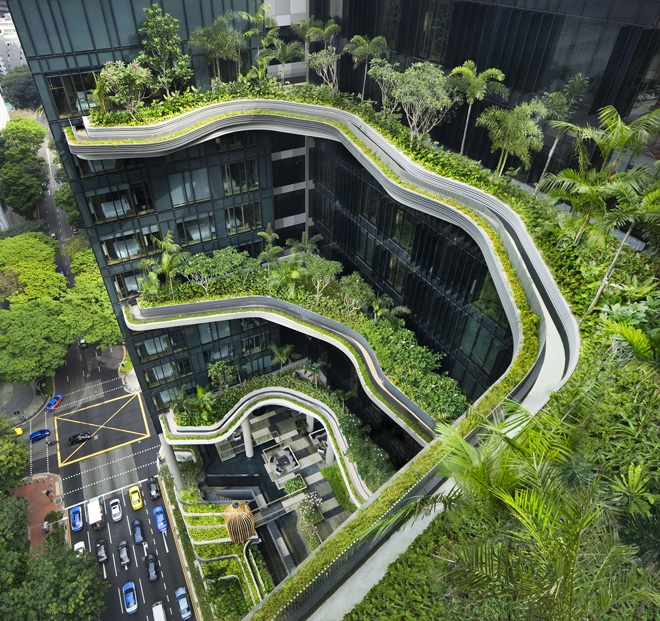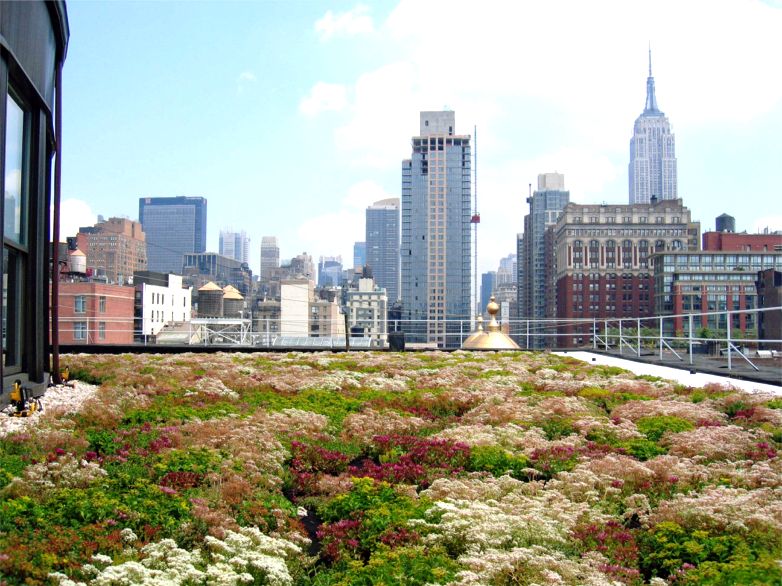From Sustainable Cities Collective:
Why are streets with trees better received than those without? Why is dappled light through leaves more pleasant than sun beating against the pavement? What is our affiliation to rolling streams and bubbling brooks? Why do little kids love playing in piles of fall leaves? According to biologist E.O. Wilson, the answer is because a connection to nature is hardwired into our DNA, leaving us with a biological propensity to feel better in the presence of natural systems.
Coined originally by social psychologist Eric Fromm, the term “Biophilia” was lifted into broader scientific discourse by E.O. Wilson in the 1980’s. In Wilson’s own words, “Biophilia is the innately emotional affiliation of human beings to other living organisms.” Though we have a tendency to narrow our field of view to the present and a maybe a few days beyond, humanity has been in the making for quite some time (about 200,000 years). For the vast majority of that time, nature was the home of our evolving ancestry, making it unsurprising that traces of our biological composition respond strongly to natural surroundings.
Changing the Way We Build
Though the scientific community has been studying biophilia for a while now, it has yet to gain familiarity throughout the general public, or even the design profession. Committing to the concept of biophilia is more than a corollary stating “nature is good,” but asserting that natural systems are a component that should be carefully designed into more (if not all) of our building and planning projects. This concept can offer a new direction for how we design the places we live and work, leading us to integrate natural systems and landscapes into our buildings in a more material way.
 Biophilia gives us another lens to assess our relationship to our chosen development patterns and underscores the need to better integrate biomass into our urban landscapes. As density rises and brings greater reflexive benefit to the proximity of residents, so too the value of land rises as well. As land becomes more expensive, the placement of biological medium relies increasingly on conscious decisions rather than residual effects of development. But the more people we have in less space, the more important that natural link becomes.
Biophilia gives us another lens to assess our relationship to our chosen development patterns and underscores the need to better integrate biomass into our urban landscapes. As density rises and brings greater reflexive benefit to the proximity of residents, so too the value of land rises as well. As land becomes more expensive, the placement of biological medium relies increasingly on conscious decisions rather than residual effects of development. But the more people we have in less space, the more important that natural link becomes.
Beyond just piece of mind and mental health, plant life helps us clean air, mitigate stormwater, reduce heat islands and promote biodiversity. We need to move past window boxes and haphazard street trees to the creation of microclimates substantial enough to support an ecosystem of their own. We have plenty of tools to work with. Combining diligent street trees with parkscape, green roofs, sky gardens, urban farms (or vertical farms), courtyards or a redefinition of the street grid can help sew natural systems through even our densest cities.
Changing the Way We Live
Biophilia also has a range of benefits to our health and well being beyond positive environmental impacts (though I would be the first to contend that our quality of life parallels that of the health of the biosphere). In their white paper titled “The Economics of Biophilia,” green consulting firm Terrapin: Bright Green combs through the various implications that this innate human reaction has on improving our quality of life. Studies show that the integration of natural systems has the capacity to reduce illness and absenteeism, increase productivity, improve classroom learning rates, increase retail sales and lower domestic violence.
Is it really a stretch to believe? We have all been in the spaces that are completely closed off from views to the outside world. Whether it is long hospital corridors, office cubicles or factory floors, being bathed in the flickering, yellow wash of out dated fluorescent fixtures, devoid of natural daylight (let alone a breeze), the isolation wears on all of us after a while. Terrapin notes studies linking patient healing time and decreased hospital stays from having access to spaces with direct views to nature with the potential to reduce healthcare costs in the neighborhood of $93 million a year.
 This is the green roof I get to look out over everyday at work. I can attest to it having a powerful impact.
This is the green roof I get to look out over everyday at work. I can attest to it having a powerful impact. The business world has comparable opportunities. Terrapin points to the fact that almost 90% of an average company’s operating costs revolve around human capital, making absenteeism and productivity powerful attributes with large monetary implications. The design of One Bryant Park focused on the principles of biophilia for this reason with the understanding that increasing the productivity of the buildings workers by even only 1% resulted in millions of dollars of benefit to the tenant company. With a country that has reportedly seen stress levels increase 30% over the last 30 years, building environments that help mitigate the stresses of the workplace could be paramount to our national health.
While I am loathe to try and pinpoint the economic value of natural systems in dollars (as some people have tried to do) it is undeniable that the health and integration of nature into our homes and jobs brings economic benefit. I find it more helpful to view nature not as valuable, but invaluable. Quantifying nature’s contributions to our quality of life will always end up falling short.
Redefining Goals
Areas of study like biophilia bring a broadening of perspective to the idea of sustainability that is sorely needed. All too often, the environmental lobby is hyper-focused on the topic of climate change rather than a holistic approach of a more sustainable culture. The aspects of biophilia operate outside of the misconception that sustainability is just a technological fix to a wasteful lifestyle, explaining not only that it is in the best interest of humanity to have a healthy biosphere, but a even more so to have a biosphere with which we are deeply integrated.


